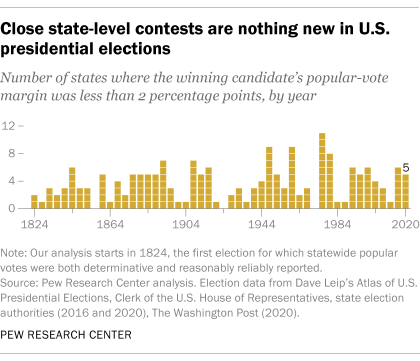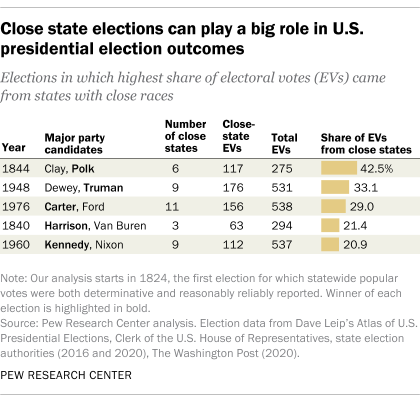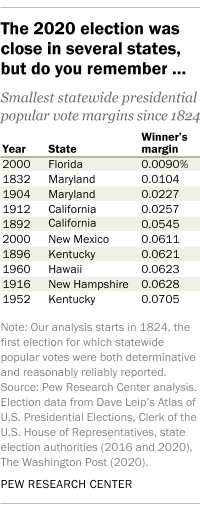Joe Biden’s victory in the presidential election was sealed by a string of close wins in several key states. Biden won Pennsylvania by just 1.2 percentage points, Wisconsin by six-tenths of a percentage point, Arizona by about a third of a percentage point, and Georgia by a quarter of a percentage point. In those four states combined, Biden beat incumbent President Donald Trump by fewer than 125,000 votes out of 18.5 million total votes cast.
Close state races, it turns out, are nothing new in U.S. presidential elections. So while we wait for the remaining states to certify their results and the electors to formally pick Biden, here’s a look back at some of the closest races of elections past, and an assessment of just how common such races are.
When it became clear that the 2020 presidential election would hinge on several exceedingly close states, we became curious as to how frequently states have had close presidential votes, and how critical those states have been to the overall election’s outcome.
We began our investigation with the 1824 election, because before then, state-level popular votes weren’t the deciding factor they soon would become. Three presidential elections before 1824 were essentially uncontested, while in the others, state legislatures chose many, if not most, of the electors.
Our main source for state-level popular vote totals was Dave Leip’s Atlas of U.S. Presidential Elections; for elections since 1920, we supplemented the Atlas with data from the Clerk of the U.S. House of Representatives. Since at this writing not all states had certified their 2020 results, we relied on The Washington Post’s vote tracker, as well as official state results when available.
For each state in each election, we determined the vote shares of the winner, the runner-up and any significant third-party candidates. The winning margin was calculated by subtracting the runner-up’s share from the winner’s share; a winning margin less than 2 percentage points meant the state counted as “close.”
Over the 50 presidential elections that have taken place since 1824, the first election for which statewide popular votes were both determinative and reasonably reliably reported, there have been 187 instances in which a state was decided by less than 2 percentage points (our definition of “close” for the purposes of this post). That’s an average of 3.74 states with close races per election.
This year, five states were “close” by our definition: In addition to the four mentioned above that Biden won, Trump carried North Carolina by 1.4 percentage points. In 2016, Trump won four of that year’s six close states.
The record high for close states in a presidential election was in 1976, when 11 states (with 156 electoral votes) were decided by less than 2 percentage points. That reflected the overall tight race between President Gerald Ford and Democratic challenger Jimmy Carter. Carter ended up beating Ford by 1.7 million popular votes out of 81.5 million cast, and by 297 electoral votes to 240.
The Carter-Ford contest was one of five elections in which close states accounted for more than a fifth of the available electoral votes. The closest election by that standard was the 1844 faceoff between Democrat James K. Polk and Whig Party standard-bearer Henry Clay: Six of the 26 then-existing states, accounting for 117 of the 275 available electoral votes (42.5%), were decided by less than 2 percentage points. The overall popular-vote margin was close, too: Polk ended up beating Clay by 39,413 votes, or 1.46 percentage points.
Since Polk defeated Clay in the Electoral College by 65 votes, that meant the close states represented enough electoral votes to shift the election. That’s happened nine other times since – most recently in 2016, when the six close states collectively cast 89 electoral votes, compared with Trump’s 77-electoral-vote margin over Hillary Clinton. This year, the five close states together accounted for 73 electoral votes, one fewer than Biden’s 74-electoral-vote margin.
No individual state has ever been closer than Florida in 2000. Republican George W. Bush was declared the winner over Democrat Al Gore by just 537 votes out of nearly 6 million cast in the state – a winning margin of 0.009 (that’s nine-thousandths) of a percentage point. The controversial race, which involved such exotic creatures as hanging chads and butterfly ballots, was eventually decided by the Supreme Court and remains burned into the memories of just about everyone who experienced it.
The only state to come close to that razor-thin margin was Maryland in 1832, when Clay carried the state over President Andrew Jackson by all of four votes (out of 38,316 cast), for a winning margin of 0.0104, or just over one-hundredth of a percentage point. But because Maryland chose its electors by district rather than winner-take-all at the time, Clay got only five of the state’s 10 electoral votes for his pains.






